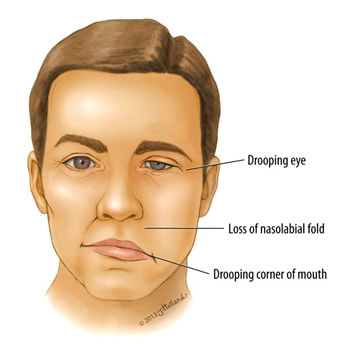Bell’s palsy is a sudden weakness or paralysis on one side of the face that makes it hard for a child to move the mouth, nose, or eyelid. It also can make that side of the face droop or look stiff.
Bell’s palsy happens when a facial nerve is not working as it should, often it occurs after a viral infection.
What causes Bell’s Palsy?
There is a facial nerve on each side of the face. When they are working properly, they carry many messages from the brain to the face. These messages may tell an eyelid to close and one side of the mouth to smile or frown.
But if the nerve swells and is compressed, as happens with Bell’s palsy, these messages don’t get sent correctly. The result is weakness or temporary paralysis of the muscles on one side of the face.
Bell’s palsy is most often connected with a viral infection such as HSV-1 (the virus that causes cold sores), Epstein-Barr (the virus that causes glandular fever), or influenza (the flu). It also can happen with ear infections, bad colds, trauma to the head or face and sometimes even with cold hair going through the ear.
What are the symptoms of Bell’s Palsy?
Bell’s palsy tends to happen quickly. Some children may feel pain behind or in front of their ears for a few hours or even days before the facial weakness sets in. Because Bell’s palsy only happens to one facial nerve at a time, it only affects one side of the face. Some kids have only slight weakness; others might not be able to move that side of their face at all. This may make one half of the child’s face (especially the mouth) seem to droop or sag.
Other symptoms can include:
- a feeling as though one side of the face is “twisting” or “tugging” (this is caused by the healthy side making facial expressions — the muscles pull on the weak side)
- headache
- trouble tasting at the front of the tongue
- trouble producing saliva
- sounds seeming louder than usual in one ear
- difficulty fully shutting one eye, causing watering and sometimes dry irritated eye
- difficulty eating and drinking as food may spill out from the side of the mouth that is weak
Bell’s palsy affects only the facial muscles, so if other parts of the body are stiff or paralyzed, talk with your doctor right away, as it may be a sign of a different condition.
Diagnosis and Treatment
There isn’t a specific test for Bell’s palsy. To make sure the paralysis is Bell’s palsy and not another condition, your doctor will ask how long it took for the symptoms to develop and where the weakness or paralysis is.
People who have strokes usually have weakness only in the lower half of their face and may have it in their arms and legs as well. The problems caused by tumors usually take longer to develop (the symptoms start more slowly and get more serious over a longer period of time) than Bell’s palsy does.
The doctor will ask if your child is having weakness or paralysis in other parts of the body, or is having other problems, like double vision or trouble swallowing. The doctor will also want to know about any head injuries.
If the facial paralysis lasts more than a few months, the doctor is likely to recommend further tests —such as magnetic resonance imaging (MRI) of the brain— to rule out other problems. The doctor also might recommend that your child have an electromyography (EMG), which tests the nerves’ signals and how well the muscles are responding to them.
Usually, the virus or infection that leads to Bell’s palsy has passed, so there’s no specific treatment used for the condition. It goes away once the swelling of the nerve goes down and the nerve recovers from any damage. The nerve has to renew itself and that can only happen with time.
In some cases, doctors recommend medicines to help reduce the swelling (steroids) or prescribe an eye patch (opticlude eye patch) or eye drops (refresh eye drops) if the eye is dry. Most children also need regular facial physiotherapy (blowing a balloon and moving the muscles of the face) and occasionally older children may receive facial nerve electrical stimulation to help recovery.
Most people recover fully within 1 to 3 months, whether or not the condition is treated, although very few may have permanent weakness in their face afterward. It is very unusual for anyone to get Bell’s palsy twice.
Making sure your child eats well and gets plenty of sleep are important to healing. Activities and sports participation don’t have to be limited as long as your child can close the eye (to protect it). If the eye can’t be closed, talk with the doctor about using protective glasses or a patch to prevent eye damage.


